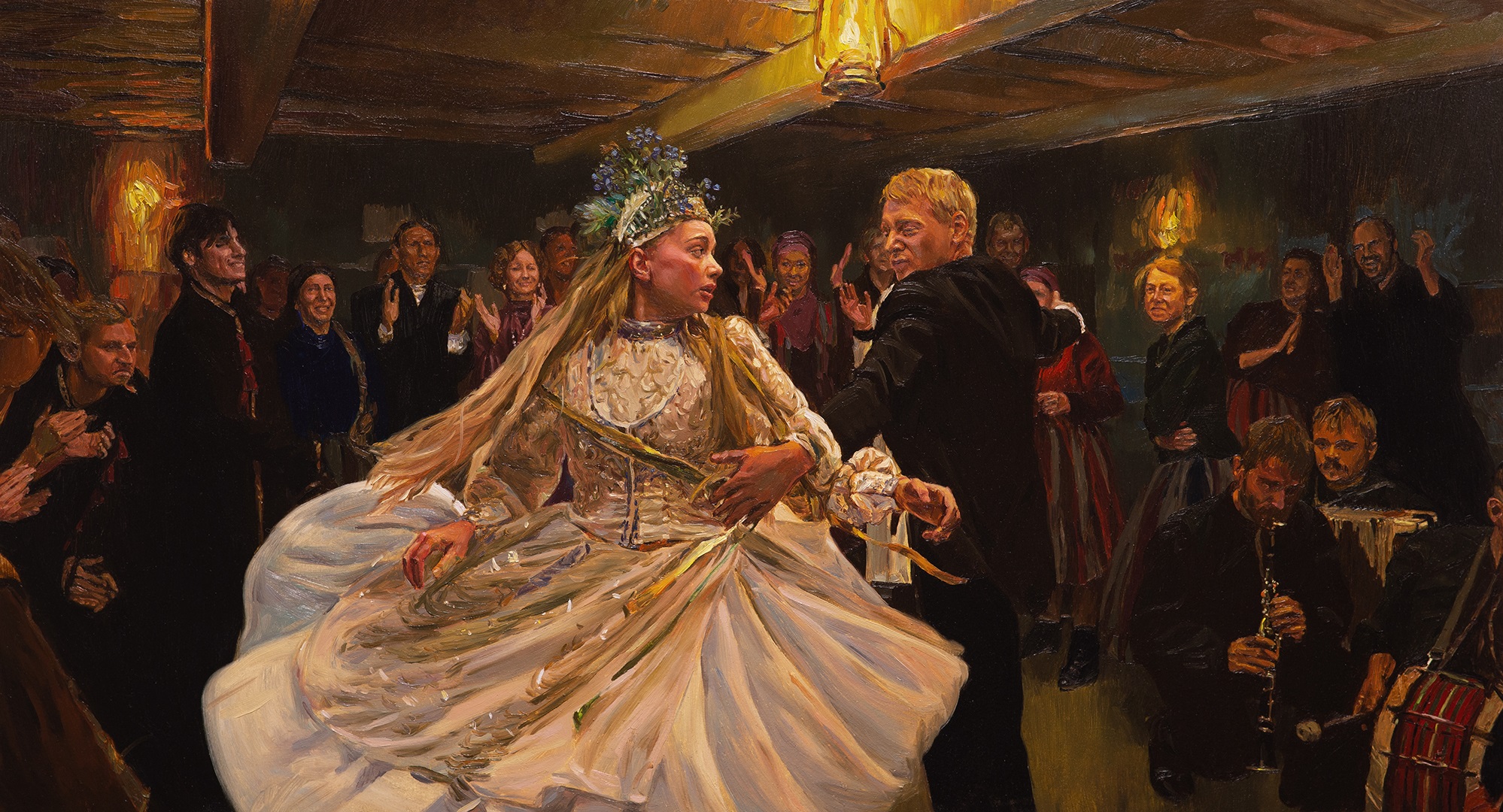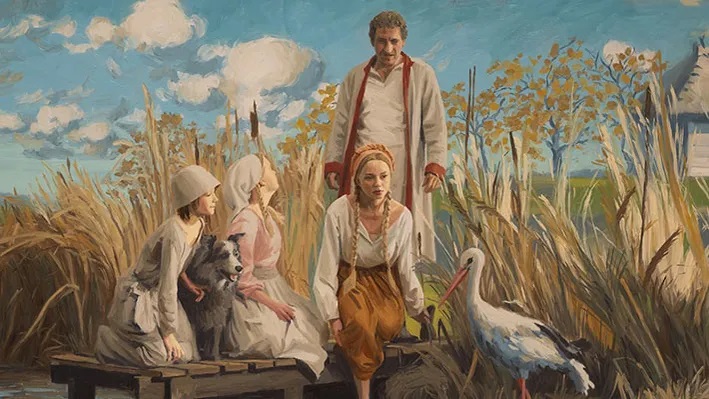








Disclaimer: spoilers."Loving Vincent" was an indie smash both inside and outside the animation community when it released in 2017. Naturally, one couldn't help but be curious on what the team would make next, if they even decided to continue after the painstaking work the first film required. Sure enough, their next film, "The Peasants," would also be painted frame by frame, and I was excited to see it in a relatively early screening in Canada in October 2023. There's a lot to admire about the movie, although the story isn't a crowdpleaser in the way that "Vincent" was. That story, from what I read, is based on a famous novel by Polish author Wladslaw Reymont (also known with the title "Chlopi"). It's a key part of Poland's culture and heritage, and it makes sense that the primarily-Polish artists of this movie would want to repeat the success of "Vincent" to celebrate their home country. The setting is a rural Polish village in the early 1900's, and starts as a juicy soap opera with passionate romance and drama. It involves the young and beautiful Jagna, still innocent but pressured to be married in a village where arranged marriages for wealth and farmland is common. The richest farmer in the area, the elderly Boryna, has his eyes on her, but Jagna has a secret and mutual yearning for the young and handsome Antek. But Antek is already married himself. And the villagers love to gossip. Scandalous! This sounds like a fun story for modern adult audiences, but where the story goes from there might shock some viewers. Split into four chapters, one for each season of the year, Jagna's life gets thrown upside-down, with dire outcomes. From the start, she's the subject of cruel rumours and assumptions, from women jealous of her beauty and not needing to work, and men who brag of their conquest of her (all false, but supporting their claim that she's just a hoar and husband-stealer). Jagna is quickly placed into a marriage she doesn't agree with, and forced to sleep with the man old enough to be her father. Because of the wealth that comes to her family from this marriage, the gossip increases. Other men attempt to rape her (unsuccessfully and successfully). Tragedy fall different people in the village, before the neighbours agree that Jagna must be the cause of all of it. They strip her and beat her near to death, leaving her naked and bruised on the edge of town. That's how the movie ends. Whatever entertainment and intrigue the film starts with disappears within the first 30 minutes, and turns into horror. All the while, Jagna is virtually innocent, a victim of circumstance. Virtually everyone else in the town is proven over and over to be cruel, selfish, and generally terrible, with slight moments of audience sympathy to how difficult their various lives are in the harsh landscape. While Jagna sometimes tries to stand up for herself, it always backfires and makes clear how helpless she is against this mob. It's difficult to watch. There's a lot that can be analyzed from the story. If able to separate yourself from the events on screen, you could imagine this as a warning to the cruelty of humanity, to show why we should help and care for each other. The audience is left to wonder whether Jagna's exile allows the village to move on and be happy, or if they will place blame on a new victim they once called a neightbour, until no one is left. The ending shot of the movie is emotionally powerful and could inspire numerous school-report essays. Curiously, the Wikipedia page for the original novel lists the main character as Boryna, with Jagna listed last, while the movie clearly puts Jagna as the lead as she experiences the whirlwind around her. The filmmakers clearly had an intentional vision for this iteration, stating in interviews they didn't want to shy away from the harsher aspects of the story. The change is focus between the novel and film could yield even more analysis.  While there is merit to the thought discussions that could be had, that doesn't stop the fact that this is an unpleasant film to watch. Which is bizarre, as this otherwise seemed to be intended as a point of pride for Poland. The village homes and clothing are rendering with great detail. The music is authentic and exciting. By all metrics, this is a great sensory example of Slavic peasant life. It's a joy to see on the big screen a culture that's rarely represented. It's a shame the people in the movie are so difficult to like in the same way. A tremendous amount of work was put into hand-painting every single frame of "The Peasants." While the theme made sense for "Loving Vincent" (an effort to recreate Van Gogh's style in every frame), for what reason was the technique used here? For one thing, I think it's silly to think we must lock a medium or technique away from being used for any story or setting, even though simpler audiences would more easily connect the dots of "painter = painting," and I'm excited to think this studio could make many more jaw-dropping works using this craft. But if you must have a reason, I've decided that the painterly style resembles oil paintings of the 1800's, reflecting the period the film takes place in, a time before photography and video cameras. Historically, this visual style is how we might know the setting by. In this way, it works and doesn't feel out of place. And yes, the visuals of the movie look spectacular. Most of it is effectively rotoscope, where live-action footage was recorded and painting was applied over it, but the amount of detail and colour in some of the shots is impressive. Occassionally, there are inspired shots (a close-up of a wedding dress comes to mind) where the border between rotoscope and painting-come-alive really vanishes, and it looks like something an experimental award-winning short film might have - it was unthinkable that a feature film could look like this! The music is also a big part of "The Peasants," featuring traditional Polish chants and waltzes that perfectly portray the dreary communal life and the tornado around Jagna spiraling out of control, such as the wedding dance where everyone parades with drunken laughter."The Peasants" really tests the limits of what can be done in an animated film across every element, from visuals and sound, to the complex adult story and themes. I think the world was already won over by the art style, but the story will likely be divisive for casual movie-goers. I wonder if I'll appreciate it's beauty differently as time passes.
While there is merit to the thought discussions that could be had, that doesn't stop the fact that this is an unpleasant film to watch. Which is bizarre, as this otherwise seemed to be intended as a point of pride for Poland. The village homes and clothing are rendering with great detail. The music is authentic and exciting. By all metrics, this is a great sensory example of Slavic peasant life. It's a joy to see on the big screen a culture that's rarely represented. It's a shame the people in the movie are so difficult to like in the same way. A tremendous amount of work was put into hand-painting every single frame of "The Peasants." While the theme made sense for "Loving Vincent" (an effort to recreate Van Gogh's style in every frame), for what reason was the technique used here? For one thing, I think it's silly to think we must lock a medium or technique away from being used for any story or setting, even though simpler audiences would more easily connect the dots of "painter = painting," and I'm excited to think this studio could make many more jaw-dropping works using this craft. But if you must have a reason, I've decided that the painterly style resembles oil paintings of the 1800's, reflecting the period the film takes place in, a time before photography and video cameras. Historically, this visual style is how we might know the setting by. In this way, it works and doesn't feel out of place. And yes, the visuals of the movie look spectacular. Most of it is effectively rotoscope, where live-action footage was recorded and painting was applied over it, but the amount of detail and colour in some of the shots is impressive. Occassionally, there are inspired shots (a close-up of a wedding dress comes to mind) where the border between rotoscope and painting-come-alive really vanishes, and it looks like something an experimental award-winning short film might have - it was unthinkable that a feature film could look like this! The music is also a big part of "The Peasants," featuring traditional Polish chants and waltzes that perfectly portray the dreary communal life and the tornado around Jagna spiraling out of control, such as the wedding dance where everyone parades with drunken laughter."The Peasants" really tests the limits of what can be done in an animated film across every element, from visuals and sound, to the complex adult story and themes. I think the world was already won over by the art style, but the story will likely be divisive for casual movie-goers. I wonder if I'll appreciate it's beauty differently as time passes.